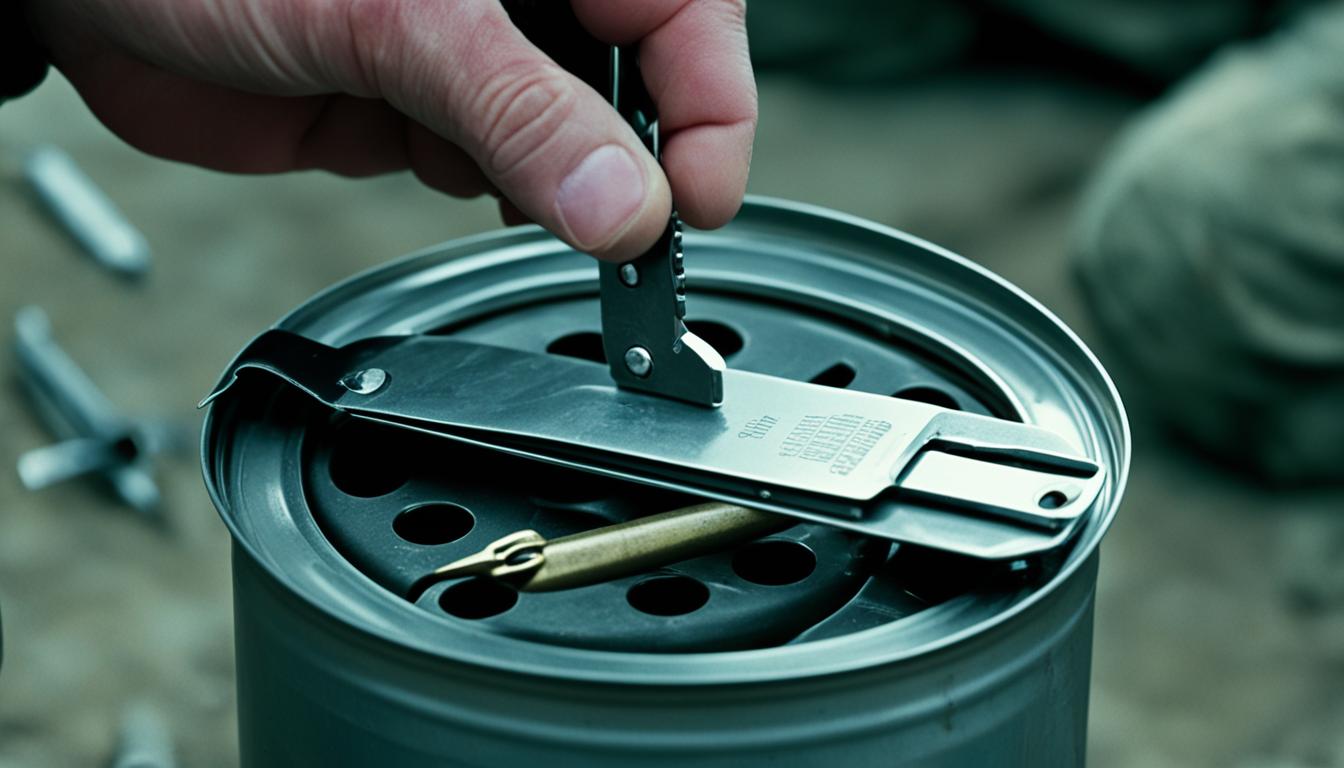In the early days of canned food history, the process of preserving food for military rations was a challenging endeavor. The quest for effective food preservation methods began in the late 18th century when the French government offered a prize to anyone who could develop a reliable technique to prevent food spoilage for soldiers on the battlefield.
Nicolas Appert, a French confectioner and chef, discovered that sealing food in airtight containers and subjecting them to heat could significantly extend their shelf life. He experimented with various containers, including champagne bottles, jars, and tin cans. By 1813, England had adopted Appert’s method and began supplying canned food to the Royal Navy.
However, the early cans posed a significant challenge for soldiers who needed to access the preserved food quickly. The cans were made of thick metal and were incredibly difficult to open without proper tools. As a result, soldiers resorted to using their bayonets or knives to cut open the cans, a practice that was both time-consuming and potentially dangerous.
Key Takeaways
- The French government offered a prize for effective food preservation methods in the late 18th century.
- Nicolas Appert discovered that sealing food in airtight containers and heating them could prevent spoilage.
- Early cans were difficult to open, requiring soldiers to use bayonets or knives.
- England adopted Appert’s method and began supplying canned food to the Royal Navy by 1813.
- The can opener was not invented until the 1850s, several decades after the introduction of canned food.
The Quest for Preserving Food in the 18th Century
Before the 18th century, humans relied on various food preservation techniques such as pickling, salting, smoking, and drying to extend the shelf life of their sustenance. However, these methods had their limitations and could not effectively preserve food for extended periods, especially during long military campaigns or overseas voyages.
In 1795, the French government recognized the need for a breakthrough in food preservation and offered a substantial prize of 12,000 francs to anyone who could develop a reliable method. This initiative caught the attention of Nicolas Appert, a French chef and confectioner, who began experimenting with different techniques to preserve food.
Appert’s initial experiments involved sealing food in champagne bottles using a mixture of cheese and lime. He later adapted this method to use wide-necked glass containers and tin cans, which proved to be more practical and efficient. Appert’s canning process involved heating the food to a high temperature, sealing it in a sterile container, and then boiling the container to eliminate any remaining bacteria.
After years of experimentation and refinement, Appert’s method was officially recognized by the French government in 1810. He was awarded the prize money and published his techniques in a book titled “The Art of Preserving Animal and Vegetable Substances for Many Years.” This groundbreaking work laid the foundation for the modern canning industry and revolutionized the way we preserve and consume food.
Appert’s canning process not only provided a solution for the military but also had far-reaching implications for the civilian population. It enabled the transportation of food over long distances, allowed for the preservation of seasonal produce, and provided a means of storing food for extended periods without the need for refrigeration.
The Evolution of Canning Techniques
Following the groundbreaking discovery by Nicolas Appert, the tin can process was further developed and refined. In 1810, Philippe de Girard allegedly pioneered the process, which was subsequently patented by Peter Durand. Bryan Donkin played a crucial role in advancing the technique of sealing food in airtight cans made of tinned wrought iron, revolutionizing the preservation and distribution of food.
In the early stages, the canning process was a time-consuming and labor-intensive endeavor, resulting in canned food being a costly commodity. The primary consumers of these canned provisions were the British Army and Royal Navy, who recognized the value of long-lasting, portable sustenance. However, as the industrialization of canning progressed and urban populations expanded, the demand for canned food surged.

The 1860s marked a significant milestone in the evolution of canning techniques. Advancements in technology and manufacturing processes enabled the production of smaller, machine-made steel cans. These innovations not only streamlined the canning process but also considerably reduced the cooking time for sealed cans to a mere thirty minutes. This increased efficiency and accessibility further fueled the growth of the canned food industry, making it more affordable and widely available to the masses.
As the industrialization of canning continued to gain momentum, it transformed the food industry and the way people consumed their meals. The ability to preserve and transport a wide variety of foods opened up new possibilities for both producers and consumers alike. The tin can process, which began as a novel concept, quickly became an integral part of the modern food landscape, shaping the future of food preservation and convenience.
The Challenge of Opening Early Cans
In the early days of canned food, the absence of can openers posed a significant challenge for consumers. The thick metal used in early can designs made them incredibly difficult to open without proper tools. Soldiers, who relied heavily on canned rations, resorted to using their bayonets or even smashing the cans open with rocks to access the contents. This crude method of opening cans not only risked injury but also potentially contaminated the food inside.
Another concerning aspect of early cans was the use of lead solder to seal them. While this method effectively preserved the food, it also introduced health risks associated with lead exposure. As canned food gained popularity among middle-class European households in the mid-19th century, the potential dangers of lead solder remained largely unknown.
The disastrous outcome of the 1845 Franklin expedition to the Northwest Passage has been attributed, in part, to lead poisoning from the expedition’s canned food supply. However, more recent studies suggest that while lead exposure may have contributed to the crew’s ill health, it may not have been the primary factor in the expedition’s tragic end. Nonetheless, the challenges posed by early can designs and the use of lead solder highlight the need for innovation in the canning industry to improve both the ease of opening and the safety of the contents.
The Invention of the Can Opener
The invention of the can opener in the 19th century revolutionized the way people consumed canned foods. In 1858, over four decades after the introduction of tin cans, American inventor Ezra Warner patented the first can opener. Warner’s design featured a bayonet and sickle mechanism, which proved difficult to operate and posed safety risks to users. While Warner’s invention marked a significant milestone, it was not until 1870 that a more practical solution emerged.
William Lyman, another American inventor, introduced a game-changing can opener design that employed a rotating wheel to cut around the rim of the can. Lyman’s invention greatly simplified the process of opening cans and laid the foundation for modern can openers. The rotating wheel can opener quickly gained popularity due to its ease of use and improved safety compared to Warner’s earlier design.
The advent of the can opener had far-reaching implications, particularly in terms of food accessibility and convenience. With a reliable tool to open cans, the demand for canned goods surged, especially during times of war when soldiers required easily transportable and long-lasting food supplies. The can opener invention not only made canned foods more accessible to the masses but also played a crucial role in shaping modern food preservation and distribution practices.

Leave a Reply